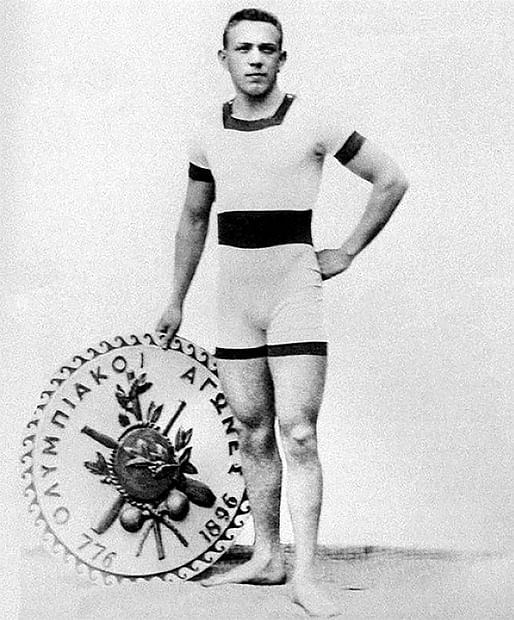

Friday's Opening Ceremony in Tokyo inaugurated the XXXII Olympiad in a dazzling spectacle that drew praise from audiences worldwide even as a growing protest against the games echoed in streets around the city. Kengo Kuma’s National Stadium provided an ample backdrop for this year’s version of a tradition begun in Ancient Greece and revived again by the progressive Olympic movement that fostered an elementary version of the modern-day games at the end of the 19th century.
Pierre de Coubertin’s intents for a combined international athletic and artistic competition traced its philosophy to the Hellenic notions of mind and body harmony and was formally observed until being dissipated by an indifferent OC as the games became more and more commercialized following World War II.
What has since become an annual exhibition saw its fulfillment in the electric arts program that preceded the ceremonial torch lighting that kicks off the Olympics following the Parade of Nations. Featuring an amazing technical display of synchronized drones, a blossoming, orb-like cauldron designed by Canadian architect Oki Sato, and a special synchronized ode to the pictogram created in 1964 to promote Tokyo’s very first Olympics, this year’s opening festivities showcased the influence of design in the games in a way perhaps unequaled in recent history.
With all of the outsized artistry on display inside the 2-million-square-foot stadium, one might be inclined to recall an earlier era of less-than Olympian feats of creativity. An era when amateurism reigned and architects competed like athletes for the gold, silver and bronze.
Pierre de Coubertin and others had been lobbying for the inclusion of arts competitions since founding the IOC in 1894. Medal categories for the fine arts, music, literature, and mixed architecture were added in 1906.
Medal categories for the fine arts, music, literature, and mixed architecture were added in 1906
The first-ever medal for architecture was given to Eugène-Edouard Monod and Alphonse Laverriére of Switzerland in 1912. The 1908 Olympiad in Rome had become the London Summer Olympics after officials responsible for planning the Italian capital’s effort gave up under the enormous financial strain of planning. The lack of adequate preparation time meant another interregnum for de Coubertin’s full vision, which was by the time of the Stockholm games gaining momentum.
World War I interrupted the planned 1916 Berlin games in a slight portent of today's ongoing global saga. The 1920 games resumed with a sole Norwegian silver medalist in the category. Two more medals were awarded in Paris in 1928, the same year architectural designs and town planning were introduced as medal categories. Jan Wils took home the gold that year for his own Olympic Stadium in Amsterdam.
John Russell Pope won a silver medal in Los Angeles in 1932 for his design of Yale’s Payne Whitney Gymnasium. A German architect named Richard Konwiarz finished behind him for his plans for a multi-purpose stadium in Breslau. The increasing professionalism of the artistic entries were by that time garnering the attention of the committee in a negative way, combining with the ascending political forces in a way that would ultimately doom the competition.
Several representatives of Nazi Germany were awarded medals in 1936, most notably Werner and Walter March in the Town planning category for their designs of the still-in-use Olympiastadion that later played host to the fraught 2006 World Cup Final. World War II brought an end to the 1940 and 1944 games and the arts medals were soon to follow. The last of each were awarded in 1948 London games, and were done away with entirely thanks to a campaign by new IOC president Avery Brundage, who believed strictly in the games’ mandate for amateurism.
Several representatives of Nazi Germany were awarded medals in 1936, most notably Werner and Walter March in the Town planning category for their designs of the still-in-use Olympiastadion that later played host to the fraught 2006 World Cup Final
Attempts to revive the medals were stalled throughout the following decades, leaving us to wonder what a less-Eurocentric modern competition might look like in an Olympic era of architecture as spectacle and the games themselves as a barometer of global society.
5 Comments
Have you got a link to the entire opening ceremony for us in the UK please as it is almost impossible to find for inexplicable reasons?
https://www.bbc.co.uk/iplayer/episode/m000y2z6/olympics-opening-ceremony
Thank you, much appreciated
Interesting history. Architecture competition in the Olympics; who knew?
And it finally redeems the phrase "he took the bronze in Antwerp" from its raunchier interpretation.
Did they get to compete whilst wearing that adorable romper?!
Block this user
Are you sure you want to block this user and hide all related comments throughout the site?
Archinect
This is your first comment on Archinect. Your comment will be visible once approved.